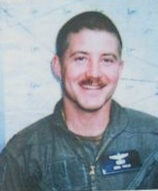War Hero, Silver Star Recipient
by Melissa LaScaleia
Captain Stephen Richard Phillis was born on May 7, 1960, in Illinois, the eldest of five siblings to parents, Richard and Diane. He grew up in Rock Island, and graduated from Rock Island Alleman High School. He graduated from the U.S. Air Force Academy at Colorado Springs, Colorado, in 1982.
From day one, Phillis had a dream to be a fighter pilot. He was a top graduate of his Fighter Weapons School class, and trained to fly the A-10 fighter craft, a plane nicknamed the “Warthog. Captain Phillis was stationed at Myrtle Beach Air Force Base and was part of the 353rd Tactical Fighter Squadron, 354th Tactical Fighter Wing. He was deployed to Saudi Arabia with his Wing in 1990, to support the United States during the war with Iraq.
On February 15, 1991, Captain Phillis went missing after a heroic feat of military aviation. It was during Operation Desert Storm, and he was mission commander of a flight to take two A-10 aircraft just north of the northwestern border of Kuwait.
The A-10 is a close-air-support aircraft that was originally designed as a tank killer, which makes them susceptible to enemy fire as they need to maintain close proximity to the ground and low-flight patterns. On this particular mission, the A-10 penetrated deeper into enemy territory than it ever had previously.
The mission was a perilous one; and after destroying an oil tanker, Captain Phillis knew they were in territory too dangerous, and called his group to return to the Iraq-Kuwait border. Along the way, they passed over the Iraqi Republican Guard’s elite Medinah Armored Division— a force in pristine condition, that stretched for 6 miles below.
Phillis’ wingman, a young first lieutenant named Robert Sweet, received missile fire from below, incapacitating his plane to such a degree that he was forced to eject. He radioed Phillis his intention to eject and then did.
Captain Phillis stayed in a dangerous line of fire, radioing to request search and rescue locate his wingman before the ejected pilot could be captured as a prisoner of war.
Calling for search and rescue support is the normal job of a mission commander, but Phillis remained to help pinpoint his lieutenant’s exact location. Without regard for his own personal safety, Phillis began to coordinate search and rescue efforts to ensure his wingman’s safety. Several minutes later, his own plane was hit by enemy fire and burst into flames.
Phillis crashed, but his fate remained unknown until March 6, when the prisoners of war were released. Sweet was among their number, but Phillis was not. He had perished in the crash.
The president of the United States posthumously awarded Phillis the Silver Star for his gallantry in action during this mission. His other awards include the Purple Heart, the Air Medal with three oak-leaf clusters, and the Air Force Commendation Medal.
He is buried in Illinois, and there are several memorials dedicated to him around the country. Phillis Blvd in the Market Common is named in his honor, and the marker commemorating him is located at the intersection of DeVille Street and Phillis Blvd.

















